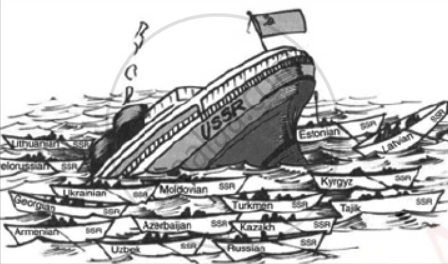Advertisements
Advertisements
प्रश्न
Analyse any three happenings during Gorbachev's period that led to the disintegration of the Soviet Union.
उत्तर
- Coup in 1991 and rise of Boris Yeltsian: In 1991, a coup was staged, encouraged by Communist Party hardliners. Boris Yeltsian was hailed as a national hero for his opposition to the coup. The Russian Republic, where Yeltsian won a popular election, started to decentralize. Power began to transfer away from the Soviet center and toward the republics, particularly in the more Europeanized parts of the Soviet Union that considered themselves as autonomous states. Under Yeltsian's leadership, Russia, Ukraine, and Belarus, the USSR's three major republics, declared the dissolution of the Soviet Union in December 1991.
- Mikhail Gorbachev’s Policy of Glasnost and Perestroika:
- Glasnost was interpreted as improved openness and transparency in Soviet Union (USSR) government institutions and activities.
- Perestroika refers to the restructuring of Soviet economic and political policy. To bring the Soviet Union's economic situation up to par with that of capitalist countries. Gorbachev decentralized economic regulations and encouraged businesses to become self-sufficient.
In 1985, Gorbachev was elected General Secretary of the Communist Party. He wished to change the Soviet system. However, other Communist Party leaders rejected his democratization plans within the country. Reforms were required to keep the USSR abreast of the West's information and technical revolutions.
- Formation of CIS (the Commonwealth of Independent States): Russia, Belarus, and Ukraine resolved in December 1991 to nullify the 1922 Treaty on the Creation of the USSR and establish the Commonwealth of Independent States (CIS). The exclusion of these republics was swiftly remedied by making them founder members of the CIS. Russia was now recognized as the Soviet Union's successor state. It took up the Soviet seat on the United Nations Security Council. Russia accepted all of the Soviet Union's international treaties and commitments. Gorbachev resigned as President of the Soviet Union on December 25, 1991, effectively dissolving the old Soviet Union.
संबंधित प्रश्न
Match the following:
| (i) Mikhail Gorbachev | (a) Successor of USSR |
| (ii) shock Therapy | (b) military Pact |
| (iii) Russia | (c) Introduced reforms |
| (iv) Boris Yeltsin | (d) Economic model |
| (v) Warsaw | (e) President of Russia |
Fill in the blank:
______________________ initiated the reforms in the USSR in 1985.
What were the factors that forced Gorbachev to initiate the reforms in the USSR?
In which year Gorbachev became the general secretary of the communist party of the U.S.S.R.?
Russia took over the U.S.S.R. seat in the U.N. in ____________.
NATO was an association of ____________.
In which year Gorbachev became General Secretary of the Communist Party of U.S.S.R.?
In which year disintegration of the Soviet Union took place?
Study the following diagram and answer accordingly.

What event officially marked the end of communism in the Soviet Union?
Study the following diagram and answer accordingly.

How was the collapse of the USSR seen by the West?
Since the end of the Cold War, the United Nations has been ______
Who initiated the reforms in the USSR in 1985?
The factors that forced Gorbachev to initiate the reforms in the USSR is/are?
Name the Soviet leader who faced a coup in the year 1991.
Discuss the developments that escalated the crisis within the USSR that hastened its Disintegration.
